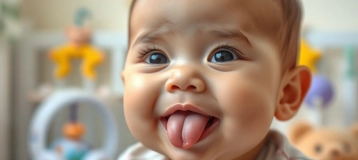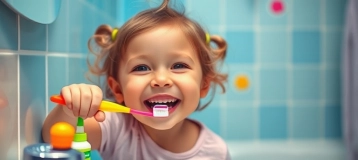The moment you feel you've mastered your baby's schedule, a new challenge emerges: teething. This phase can be a confusing time for parents, often marked by a fussy baby and a lot of drool. Understanding what to expect can make the process much smoother for both you and your little one.
What is Teething and When Does it Happen?
Teething is the process of a baby’s teeth pushing through the gums. It's not a single event but a series of changes that occur throughout their early years. According to the American Dental Association, this journey typically begins around six months of age, though the timing can vary. Here is a general timeline for when new teeth might appear:
6-10 months: The two front bottom teeth (central incisors) usually come in first.
8-12 months: The two front top teeth (central incisors) follow.
9-13 months: The top lateral incisors (the teeth next to the front ones) emerge.
10-16 months: The bottom lateral incisors arrive.
13-19 months: The first molars (back teeth) appear on the top.
14-18 months: The first molars on the bottom join them.
16-22 months: The top canines ("fangs") appear.
17-23 months: The bottom canines come through.
23-31 months: The second molars on the bottom arrive.
25-33 months: The last teeth to appear are the second molars on the top, completing the set.
Remember, this timeline is a general guide. If your baby's teeth arrive earlier, later, or in a different order, it's usually no cause for concern. However, if their first tooth hasn't appeared by their first birthday, it's a good idea to consult your dentist.
Recognizing the Signs of Teething
teething symptoms can be unique to each child, with some babies experiencing significant discomfort while others show no signs at all. However, some common indicators can help you determine if a tooth is on the way:
Excessive Chewing: You might notice your baby chewing, biting, or rubbing their gums on anything they can get their hands on, from toys to their own fingers.
Increased Drooling: Teething often causes a significant increase in saliva production. This can sometimes lead to a mild rash around the chin and cheeks. Gently patting your baby's chin dry and changing wet clothes can help prevent irritation.
Fussiness and Irritability: If your baby seems more cranky, upset, or tearful than usual, it could be a sign of gum tenderness and discomfort.
Restless Sleep: A baby who was sleeping well might suddenly start waking up more frequently at night or resisting naps due to the pain.
Loss of Appetite: A sore mouth can make nursing or eating uncomfortable. If your baby is refusing food, it might be due to teething. Always consult your pediatrician if you are worried about their intake.
Dispelling Teething Myths
It’s important to know what isn't a sign of teething. While many believe that fever, diarrhea, and widespread skin rashes are symptoms, the American Dental Association (ADA) and other health professionals caution against this. A slight increase in temperature might occur, but a true fever (100°F or higher) is not a normal part of teething. Likewise, while drool can cause a minor rash on the face, rashes on other parts of the body or diarrhea are often signs of other illnesses. If your baby shows these symptoms, contact your pediatrician immediately to rule out other medical issues.
Soothing Your Teething Baby
When your baby is uncomfortable, your natural instinct is to provide relief. Here are some safe and effective ways to help ease their pain:
Chilled Items: Give your baby a refrigerated (not frozen) teething ring or a clean, cool washcloth to chew on.
Gentle Gum Massage: Use a clean finger or a baby finger brush to gently massage their gums. This can provide pressure and comfort.
Cool Foods and Drinks: For older babies, cold fruits or vegetables can be soothing on their sore gums.
Dryness is Key: Keep their skin dry by wiping away drool to prevent rashes and discomfort.
Cuddles and Comfort: Sometimes, the best remedy is a lot of love and reassurance. A comforting hug can make all the difference.
Be cautious with over-the-counter products. The U.S. Food and Drug Administration (FDA) advises against teething gels containing benzocaine for children under two, as they can cause serious side effects. Always check with your pediatrician before giving your baby any teething products or pain medication.
Caring for New Teeth
Oral hygiene should begin even before the first tooth appears. Gently clean your baby's gums with a soft, moist cloth or gauze after feedings to get them used to the routine. Once the first tooth arrives, it's time to start brushing. Use a tiny smear of fluoride toothpaste (the size of a grain of rice) and a soft baby toothbrush. The American Academy of Pediatrics recommends a child's first dental visit by their first birthday, or when the first tooth emerges, to ensure proper oral development and get expert advice.
Teething can be a challenging time, but it is temporary. With the right knowledge and a lot of patience, you can help your baby through this phase and celebrate that first little toothy grin!
Pro Tip
The content of the article is shared by netizens, please carefully identify it





